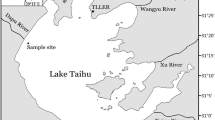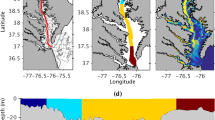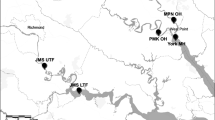Abstract
We examined sediment resuspension and light attenuation in relation to the potential for macrophytes to improve water quality conditions in Peoria Lake, Illinois (U.S.A.). The lake exhibited high total suspended solids (TSS) loading and retention of predominantly fine-grained particles in 2000. Large fetches along prevailing wind rose, coupled with shallow morphometry and sediment particles composed of >90% silt and clay resulted in frequent periods of sediment resuspension. As calculated (wave theory) shear stress increased above the critical shear stress (measured experimentally), turbidity increased substantially at a resuspension monitoring station. Resuspension model explorations suggested that establishment of submersed aquatic macrophytes could substantially reduce sediment resuspension in Peoria Lake. However, K d is currently very high, while Secchi transparency low, at in-lake stations. Thus, in order to establish a persistent macrophyte population in the lake to control resuspension, the underwater light regime will have to improve quite dramatically.
Similar content being viewed by others
References
APHA (American Public Health Association), 1992. Standard Methods for the Examination ofWater andWastewater, 18th edn. American Public Health Association, Washington, D.C.
Bailey, M. C. & D. P. Hamilton, 1997. Wind induced sediment resuspension: a lakewide model. Ecological Modeling 99: 217–228.
Barko, J. W. & W. F. James, 1998. Effects of submerged aquatic macrophytes on nutrient dynamics, sedimentation, and resuspension. In Jeppesen, E., M. Søndergaard, M. Søndergaard, K. Christoffersen (eds), The Structuring Role of Submerged Macrophytes in Lakes. Springer-Verlag, New York, NY. 423 pp.
Bengtsson, L. & T. Hellström, 1992. Wind induced resuspension in a small shallow lake. Hydrobiologia 241: 163–172.
Blom, G., E. H. S. Van Duin & L. Lijklema, 1994a. Sediment resuspension and light conditions in some shallow Dutch lakes. Water Science and Technology 30: 243–252.
Blom, G., E. H. S. Van Duin & J. E. Vermaat, 1994b. Factors contributing to light attenuation in Lake Veluwe. In Van Vierssen (ed.), Lake Veluwe, a Macrophyte-Dominated System Under Eutrophication Stress. Kluwer Academic Publishers, Dordrecht: 158–174.
Carper, G. L. & R. W. Bachmann, 1986. Wind resuspension of sediments in a prairie lake. Canadian Journal of Fisheries and Aquatic Sciences 41: 1763–1767.
Coastal Engineering Research Center, 1984. Shore Protection Manual, Vol. 1. U.S. Army Corps of Engineers, Waterways Experiment Station, Vicksburg, Mississippi, USA.
Dieter, C. D. 1990. The importance of emergent vegetation in reducing sediment resuspension in wetlands. Journal of Freshwater Ecology 5: 467–473.
Doyle, R. D. & R. M. Smart, 2001. Impacts of water column turbidity on the survival and growth of Vallisneria americana winter buds and seedlings. Lake and Reservoir Management 17: 17–28.
Hamilton, D. P. & S. F. Mitchell, 1996. An empirical model for sediment resuspension in shallow lakes. Hydrobiologia 317: 209–220.
Hellström, T. 1991. The effect of resuspension on algal production in a shallow lake. Hydrobiologia 213:183–190.
James, W. F. & J. W. Barko, 1990. Macrophyte influences on the zonation of sediment accretion and composition in a northtemperate reservoir. Archiv für Hydrobiologie 120: 129–142.
James, W. F. & J. W. Barko, 1994. Macrophyte influences on sediment resuspension and export in a shallow impoundment. Lake and Reservoir Management 10: 95–102.
James, W. F., J. W. Barko & M. G. Butler, 2003. Shear stress and sediment resuspension in relation to submersed macrophyte biomass. Hydrobiologia (in press).
Jeppesen, E., M. Søndergaard, M. Søndergaard & K. Christoffersen, 1998. The Structuring Role of SubmergedMacrophytes in Lakes. Ecological Studies 131, Springer-Verlag, New York, 423 pp.
Kimber, A., J. L. Owens & W. G. Crumpton, 1995a. Light availability and growth of wild celery (Vallisneria americana) in upper Mississippi River backwaters. Regulated Rivers 11: 167–174.
Kimber, A, C. E. Korschgen & A. G. Van Der Valk, 1995b. The distribution of Vallisneria americana seeds and seedling light requirements in the upper Mississippi River. Canadian Journal of Botany 73: 1966–1973.
Koch, E. W., 1996. Hydrodynamics of a shallow Thalassia testudinum bed in Florida, USA. In Kuo, J., R. C. Phillips, D. I. Walker & H. Kirkman (eds), Seagrass Biology: Proceedings of an International Workshop, Rottnest Island, Western Australia, 25-29 January 1996: 105-109.
Korschgen, C. E., W. I Green & K. P. Kenow, 1997. Effects of irradiance on growth and winter bud production by Vallisneria americana and consequences to its abundance and distribution. Aquatic Botany 58: 1–9.
Lavelle, J. W. & H. O. Mofjeld, 1987. Do critical stresses for incipient motion and erosion really exist? ASCE Journal of Hydraulic Engineering 113: 370–385.
Lick, W., Y.-J. Xu & J. McNeil, 1995. Resuspension properties of sediment from the Fox, Saginaw, and Buffalo Rivers. Journal of Great Lakes Research 21: 257–274.
Luettich, R. A., D. R. F. Harleman & L. Somyódy, 1990. Dynamic behavior of suspended sediment concentration in a shallow lake perturbed by episodic wind events. Limnology and Oceanography 35: 1050–1067.
Plumb, R. H., 1981. Procedures for handling and chemical analysis of sediment and water samples. Technical Report EPA/CE-81-1. U.S. Army Engineer Waterways Experiment Station, Vicksburg, Mississippi.
Roberts, J., R. Jepsen, D. Gotthard & W. Lick, 1998. Effects of particle size and bulk density on erosion rates of quartz particles. ASCE Journal of Hydraulic Engineering 124: 1261–1267.
SAS (Statistical Analysis System). 1994. SAS users guide. Statistics, version 6 edition. SAS Institute, Cary, North Carolina, USA.
Scheffer, M., 1990. Multiplicity of stable states in freshwater systems. Hydrobiologia 200/201: 475–486.
Scheffer, M., H. S. Hosper, M. L. Meijer, B. Moss & E. Jeppesen, 1993. Alternative equilibria in shallow lakes. Trends in Ecology and Evolution 8: 275–279.
Scheffer, M., 1998. Ecology of Shallow Lakes. Chapman & Hall, New York, 357 pp.
Smart, R. M. & G. O. Dick, 1999. Propagation and establishment of aquatic plants: A handbook for ecosystem restoration projects. Technical Report A-99-4, U.S. Army Engineer Waterways Experiment Station, Vicksburg, MS.
Søndergaard, M., P. Kristensen & E. Jeppesen, 1992. Phosphorus release from resuspended sediment in the shallow and windexposed Lake Arresø, Denmark. Hydrobiologia 228: 91–99.
Tsai, C. H. & W. Lick, 1986. A portable device for measuring sediment resuspension. Journal of Great Lakes Research 12: 314–321.
Van Duin, E. H. S., 1992. Sediment transport, light and algal growth in the Markermeer. PhD thesis, Wageningen Agricultural University, Wageningen, 274 pp.
Van Duin, E. H. S., G. Blom, L. L. Lijklema & M. J. M. Scholten, 1992. Some aspects of modeling sediment transport and light conditions in Lake Marken. In Hart, B. T. & P. G. Sly (eds), Sediment/Water interactions. Hydrobiologia 235/236: 167–176.
Walker, W. W., 1996. Simplified procedures for eutrophication assessment and prediction: User manual. Instruction Report W-96-2, U.S. Army Engineer Waterways Experiment Station, Vicksburg, MS.
Author information
Authors and Affiliations
Rights and permissions
About this article
Cite this article
James, W.F., Best, E.P. & Barko, J.W. Sediment resuspension and light attenuation in Peoria Lake: can macrophytes improve water quality in this shallow system?. Hydrobiologia 515, 193–201 (2004). https://doi.org/10.1023/B:HYDR.0000027328.00153.b2
Issue Date:
DOI: https://doi.org/10.1023/B:HYDR.0000027328.00153.b2




